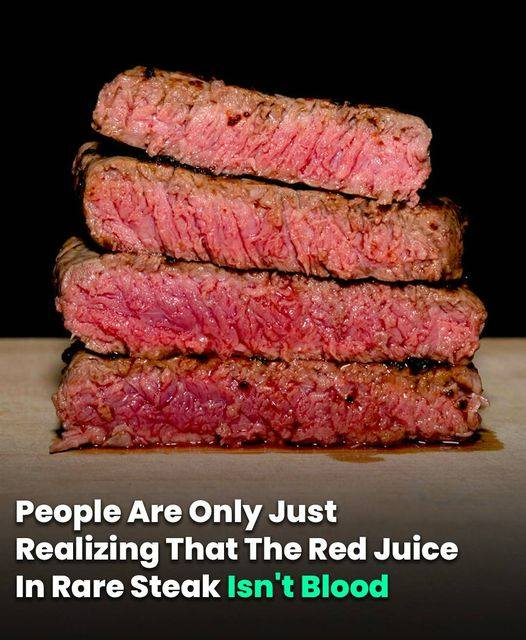We all have our favorite way of enjoying steak, whether it’s rare, medium, or well done. But if you’ve ever looked closely at a steak in the butcher’s case or in the grocery store, you might have noticed a red liquid seeping out of it. Naturally, many people assume this liquid is blood. However, that assumption is incorrect.

Social Media Reactions to the Discovery
Recently, social media has been buzzing as people discover that the red juice in a rare steak isn’t actually blood. One user on X (formerly known as Twitter) wrote, “I was today years old when I learned that the red liquid in rare steak isn’t blood.” Another user added, “I did not know that!” Meanwhile, someone else reacted more strongly, saying, “That’s worse; I don’t even know what that is.” Clearly, this revelation has sparked confusion and curiosity.
So, what exactly is this mysterious pinkish-red liquid that seeps from the steak? Let’s break it down.
What’s Really in That Steak Package?
When beef is processed, almost all of the blood is removed during the slaughtering process. By the time the steaks reach the butcher or grocery store, there’s very little blood left in the meat, even with the freshest cuts. The red liquid you see in packaged steak is actually something called “purge.”
According to Bearded Butchers, “All meat is around 75% water, held within the cells of the muscle tissue.” When meat is frozen and then thawed, this liquid is released. This is due to ice crystals forming inside the meat during freezing, which can damage the muscle cells. As the meat defrosts, water and myoglobin—a protein found in muscle tissue—leak out.
That’s the reason you often see cuts of meat packaged with an absorbent pad. These pads are designed to soak up the purge and keep the package looking neat.
Why Does Steak Purge Look Like Blood?
While the purge might look like blood, it’s mostly made up of water and myoglobin. Myoglobin is a protein that’s responsible for giving red meat its color. It’s more concentrated in the muscles of older animals, which is why beef has more of a bloodlike appearance compared to pork or chicken.
Steak School explains that cows are typically slaughtered at an older age than pigs, which results in a higher myoglobin content in beef. As a result, the liquid that leaks from beef steaks has a more reddish hue than the liquid found in pork, which is often lighter and less bloodlike.
How Does Myoglobin Affect Cooking?
As you cook a steak, the myoglobin in the meat reacts to the heat, causing it to darken and change color. That’s why a rare steak, which is only lightly cooked, often appears “bloody.” Meanwhile, a well-done steak loses most of its moisture during cooking, leading to a grayish-brown color.
Bearded Butchers further advises that purge should be handled with the same care as raw meat. They recommend avoiding meat packages with excessive amounts of purge, as this can affect the flavor and quality of the meat. When a package has a lot of purge, the meat has lost some of its moisture and tenderness, making it less tasty.
Why Letting Meat Rest Matters
To maximize flavor and juiciness, it’s essential to let meat rest after cooking. This resting period allows the juices to reabsorb into the meat, making each bite more flavorful. When a steak comes off the grill, for example, the resting process helps retain moisture, resulting in a juicier, more satisfying meal.
The Takeaway: It’s Not Blood
The red liquid that oozes from rare steak isn’t blood at all. It’s a combination of water and myoglobin, a protein found in muscle tissue. While it might look unappetizing to some, it’s entirely normal and doesn’t pose any health risks. The next time you order a rare steak, you can rest easy knowing that the red juice isn’t what you might have thought it was.
In summary, while the sight of red liquid in your steak package may initially be unsettling, it’s a natural part of meat composition. Understanding what’s actually in the steak can make it easier to enjoy your favorite cut—whether it’s rare, medium, or well done. And next time someone mistakenly calls it “blood,” you’ll be able to set the record straight.





